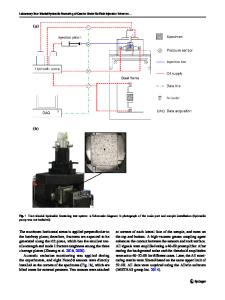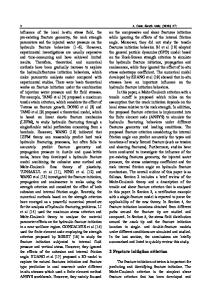True triaxial hydraulic fracturing test and numerical simulation of limestone
- PDF / 3,150,226 Bytes
- 15 Pages / 595.22 x 842 pts (A4) Page_size
- 66 Downloads / 285 Views
True triaxial hydraulic fracturing test and numerical simulation of limestone YANG Wei-min(杨为民)1, 2, GENG Yang(耿阳)1, ZHOU Zong-qing(周宗青)1, 2, LI Lian-chong(李连崇)3, DING Ruo-song(丁若松)1, WU Zhong-hu(邬忠虎)4, ZHAI Ming-yang(翟明洋)3 1. School of Qilu Transportation, Shandong University, Ji’nan 250061, China; 2. Geotechnical and Structural Engineering Research Center, Shandong University, Ji’nan 250061, China; 3. School of Resources and Civil Engineering, Northeastern University, Shenyang 110006, China; 4. College of Civil Engineering, Guizhou University, Guiyang 550025, China © Central South University Press and Springer-Verlag GmbH Germany, part of Springer Nature 2020 Abstract: Hydraulic fracturing, as a key technology of deep energy exploitation, accelerates the rapid development of the modern petroleum industry. To study the mechanisms of hydraulic fracture propagation and rock failure mode of the vertical well hydraulic fracturing, the true triaxial hydraulic fracturing test and numerical simulation are carried out, and the influence of the principal stress difference, water injection displacement, perforation angle and natural fracture on fracture propagation is analyzed. The results show that the fracture propagation mode of limestone is mainly divided into two types: the single vertical fracture and the transverse-longitudinal crossed complex fracture. Under high displacement, the fracturing pressure is larger, and the secondary fracture is more likely to occur, while variable displacement loading is more likely to induce fracture network. Meanwhile, the amplitude of acoustic emission (AE) waveform of limestone during fracturing is between 0.01 and 0.02 mV, and the main frequency is maintained in the range of 230−300 kHz. When perforation angle θ=45°, it is easy to produce the T-type fracture that connects with the natural fracture, while X-type cracks are generated when θ=30°. The results can be used as a reference for further study on the mechanism of limestone hydraulic fracturing. Key words: true triaxial; hydraulic fracturing; acoustic emission; particle flow code (PFC); perforation angle; natural fracture Cite this article as: YANG Wei-min, GENG Yang, ZHOU Zong-qing, LI Lian-chong, DING Ruo-song, WU Zhong-hu, ZHAI Ming-yang. True triaxial hydraulic fracturing test and numerical simulation of limestone [J]. Journal of Central South University, 2020, 27(10): 3025−3039. DOI: https://doi.org/10.1007/s11771-020-4526-4.
1 Introduction Hydraulic fracturing, as a key technology of deep energy exploitation, greatly improves the permeability of deep low-permeability reservoir rock and accelerates the rapid development of the modern petroleum industry, energy extraction and other fields, showing a wide range of industrial
applications [1−3]. Besides, hydraulic fracturing can lead to the phenomenon of cracking, damage expansion, and even overall instability of surrounding rocks in tunnel engineering, which brings great challenges to tunnel construction and operation [4, 5]. Therefore, it is particularly important to fully
Data Loading...











